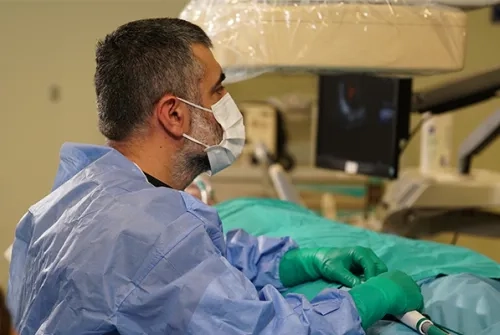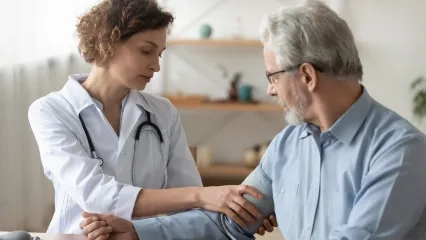Alo Yeditepe
Alo Yeditepe
Technique Developed by a Turkish Doctor Has Become Part of Literature; Is Now an Alternative to Pacemakers
The ‘Cardioneuroablation’ technique, defined as an ‘option to treat by ablation’ for patients who are 40 years of age or younger, and have a problem with cardiological transmitting and fainting, without the need of a pacemaker by Prof. Dr. Tolga Aksu, Cardiology Specialist, has earned its place in world’s literature.
Stating that they have applied the technique to more than 500 patients in Turkey, including pregnant women, Prof. Dr. Aksu stated that they had near 100% success. Prof. Dr. Aksu also stated that the technique they have been working on for 7 years have been published as a research article on ‘Circulation: Arrhytmia and Electrophysiology’, world’s most prestigious journal, as well as having a high impact factor, on arrhythmia.
Explaining that there was a need for a less invasive treatment for a long time now, Prof. Dr. Tolga Aksu, Yeditepe University Kozyatağı Hospital Cardiology Specialist, stated the following: “We first applied the technique on a patient in 2014. Our focal point was the necessity for application of a pacemaker especially in young patients, under 40 years of age, who have a problem of fainting due to heart stopping. Pacemakers require a surgical intervention. Because there is a need for an incision to place the pacemaker generator. We used to send various cords to the heart from this generator. Following that, patients had to avoid physical exertion for about three months. Young female patients had a visual concern for such an incision as well. After some ablations, we observed the increase in heart rate, and studied it, thinking whether we can make it a universal technique that other doctors can also apply”.
International Success
Publishing his first studies in 2015, Prof. Dr. Tolga Aksu explained: “The first case we applied the technique has been selected as the “best case” in European Arrhythmia Association in Nice, France. That was the beginning of our journey. The following year, we presented the 16 case results in a meeting of American Heart Rate Association. We received encouraging feedbacks. Afterwards, in 2017, in Prague, I had the first live case. We shared how to treat these cases with other electrophysiology and arrhythmia doctors. As our knowledge regarding the technique increased, we also had the chance to explain the procedure in person or online to other doctors around the world”.
Published in ‘Circulation: Arrhythmia And Electrophysiology’
Stating that “The patients with a problem between auricula and ventricles, the most difficult ones, can be applied this technique and we published this information in the world’s highest impact-factor arrhytmia journal, ‘Circulation: Arrhytmia and Electrophysiology”, Prof. Dr. Tolga Aksu also said; “It had a great impact because there have been present cases. Yet, it was the first time all the data has been presented as a research article. We also follow-up on the patients we applied this technique, and it was also explained in the article”.
A New Treatment Option Without Pacemaker!
Stating that in 20-30 percent of patients who have heart rate issues and require a pacemaker can be treated with ablation with no pacemakers and no permanent scars, Cardiology Specialist Prof. Dr. Tolga Aksu stated: “With ablation, we evaluate and treat the patient’s heart in a three-dimensional model. We developed a technique to find out the parts of the nerve system that result in low heart rate. We can do this with no need for extra equipment that require a high budget. Naturally, an experienced and trained electrophysiologist can apply this method everywhere around the world”.
People Return to Their Normal Life the Next Day
Explaining that the patient does not need to restrict his movements without wearing a pacemaker, Prof. Dr. Aksu stated, “When we implant a pacemaker, we ask the patient not to do some movements such as lying down and lifting, especially for the first month. The day after the ablation, the patient continues his/her life normally. He/she can walk, run, and do whatever he/she wants. We can say that the new treatment method is an alternative to a pacemaker in suitable patients. This year, I gave speeches about the method at more than 10 scientific congresses. It is also discussed as an alternative in different countries of the world. We have a higher chance of treating young patients by applying this method without a pacemaker, compared to elderly patients. It is not a very painful procedure, and it is done comfortably. However, this method cannot be applied in every hospital without a three-dimensional mapping system or a specialist with high experience in this field.”
Patient Is Back to Daily Life Next Day
Stating that a patient has to limit his physical movement when a pacemaker is applied, Prof. Dr. Aksu stated the following: “When we applied a pacemaker, we ask the patient not to do movements such as reaching or lifting. In ablation treatment, the patient can go back to his daily life the next day. He can walk, run and do anything. We can claim that this new treatment is an alternative to pacemakers in appropriate patients. This year, I have given speeches on the method over 10 congresses. It is being talked about in various countries as well. In young patients, our chances of treatment without a pacemaker is higher than older patients. It is not a procedure with a lot of pain. Yet, without a three-dimensional mapping system or a highly experienced expert, the method cannot be applied”.
The Aim is Global Use
Stating that anything is possible with effort, Prof. Dr. Aksu said “My aim is to have this procedure globally used. I want patients in different countries to be able to reach this procedure. Pandemic period gave us some advantages. We have treated about 500 patients so far. This is a team effort and we have a great team here. This is one of the major reasons of our success”.
The Technique was Explained at Important Congresses Abroad
Emphasizing the fact that he is proud for his achievements, Yeditepe University Kozyatağı Hospital Cardiology Specialist Prof. Dr. Aksu stated the following: “I hvave been invited to the American Heart Rate Association meeting for the third time now, if we consider 2022 as well. The important part here is being able to explain our own method in America. The Association is the biggest arrhythmia platform in America. I have also spoken in gerenal cardiology congresses of America and explained the method. It is great to have been created the acknowledged alternative treatment and present it with data to support. It is also great pride for me to show that this will be done in Turkey”.
Press Coverage: haberturk | yeniakit | ahaber | posta | gazetevatan | aksam | mynet | ahaber
This content was prepared by Yeditepe University Hospitals Medical Editorial Board.
Alo Yeditepe


